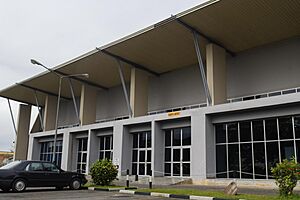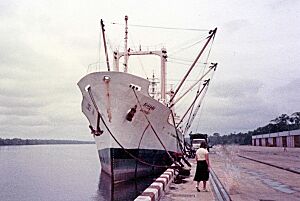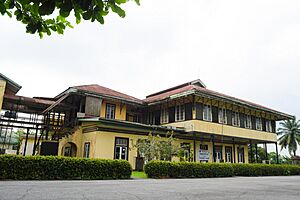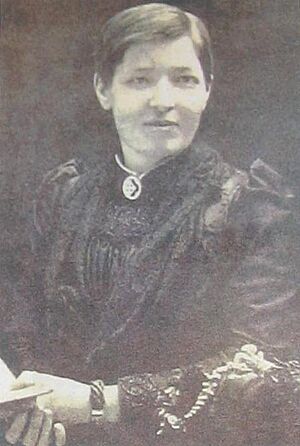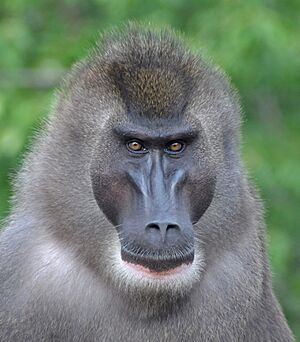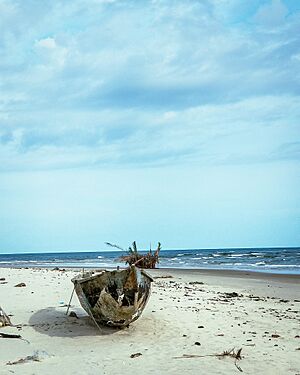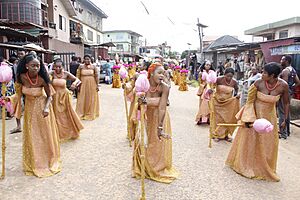Calabar facts for kids
Quick facts for kids
Calabar
Callabar, Calabari, Calbari, Cali, Kalabar
|
|
|---|---|
|
City
|
|

Giant Hand Sculptures near National Museum, Calabar.
|
|
| Country | |
| State | Cross River |
| Area | |
| • Total | 406 km2 (157 sq mi) |
| Elevation | 32 m (105 ft) |
| Population
(2006)
|
|
| • Total | 371,022 |
| • Estimate
(2022)
|
571,500 |
| • Density | 913.8/km2 (2,366.9/sq mi) |
| GDP (PPP, 2015 int. Dollar) | |
| • Year | 2023 |
| • Total | $4.8 billion |
| • Per capita | $7,300 |
| Time zone | UTC+1 (WAT) |
| Climate | Am |
Calabar is a major city in Nigeria. It is the capital of Cross River State. People also call it by names like Callabar or Kalabar. The city was first known as Akwa Akpa in the Efik language. The Efik people are the main group living here.
Calabar is located near the Calabar and Great Kwa rivers. It is also close to the creeks of the Cross River. The city is split into two parts for local government: Calabar Municipal and Calabar South. In 2006, about 371,022 people lived here. By 2022, the population was estimated to be around 571,500.
Calabar was once called the "tourism capital" of Nigeria. This was thanks to efforts by Governor Donald Duke from 1999 to 2007. The city became known for being very clean and eco-friendly.
Contents
Calabar's Rich History
Early Seaport and Trade
When Portuguese explorers arrived in the 1400s, they named the local tribes "Calabar". The first people living here were the Quas. Later, in the 1700s, the Efik people moved to Calabar from the Niger River area. They were looking for a new home after conflicts with other groups.
Since the 1500s, Calabar has been an important international seaport. It was used to export goods like palm oil. For a long time, it was also a major port for the Atlantic slave trade. Many African people were taken from here to the Americas.
Between 1725 and 1750, about 17,000 enslaved Africans were sold from Calabar. From 1772 to 1775, this number grew to over 62,000. Old Calabar (Duke Town) and Creek Town were key places for this trade.
In 1807, Great Britain made the slave trade illegal. In 1815, a British ship, HMS Comus, sailed to Duke Town. It captured seven Spanish and Portuguese ships involved in the slave trade.
John Jea, an enslaved African American who later became a writer, came from this area. A small community of mixed-race merchants also lived here. They had connections to other trading groups across the Atlantic.
Missionaries and Social Change
In 1846, Scottish Presbyterians started a mission in Calabar. Missionaries like Hope Waddell (1845-1858) and Mary Slessor (1876-1915) worked to improve life for the local people. They taught about Christianity and helped change some old traditions.
They worked to stop practices like:
- Killing newborn twins.
- Human sacrifice when village elders died.
- Using poison to decide if someone was guilty of a crime.
These missionaries also started a school for African students. They helped protect water supplies and tried to control mosquitoes to prevent diseases like yellow fever. Today, streets and squares in Calabar are named after Waddell and Slessor to honor their work.
Calabar in Colonial Times
On September 10, 1884, Queen Victoria signed a treaty with the king and chiefs of Akwa Akpa (Old Calabar). This treaty allowed the United Kingdom to control the area around Calabar, including Bakassi. Calabar became the main European administrative center in the Niger Delta. However, in 1906, the government seat moved to Lagos.
Calabar achieved many "firsts" in Nigeria:
- It had the first secondary school, the Hope Waddell Training Institution.
- It had the first hospital, St Margaret's.
- It was home to Nigeria's first female pharmacist and first female politician, Margaret Ekpo.
- It had Nigeria's first librarian and first dark-skinned professor, Eyo Ita.
- It was the first Nigerian city with a post office and a military barracks.
- It was the first Nigerian city with paved roads and a botanical garden.
- It even had Africa's first monorail, though it is no longer in use.
- It was known as "Nigeria's cleanest city."
From 1914 to the 1960s, a mail ship from Liverpool visited Calabar monthly. It brought letters, parcels, newspapers, and carried passengers to other Nigerian cities.
In 1922, British Governor Clifford created the Legislative Council. Four members were elected, one from Calabar and three from Lagos. This council made laws and approved the country's budget. These four were the first Africans elected to a parliament in British West Africa.
The Clifford Constitution led to the first political parties in Nigeria. Herbert Macaulay founded the Nigerian National Democratic Party in 1923.
In 1926, Governor Graeme Thomson tried to introduce a new tax. This led to strong protests, especially from women. Nigerians called it the "Women's War," and the British called it the "Aba Riots." These protests spread to Calabar. Several government buildings were damaged, and many women died during clashes with colonial forces.
Calabar During the Biafra War
After Nigeria gained independence in 1960, tensions grew between the northern and southern parts of the country. The southeastern area, including Calabar, declared itself independent as the Republic of Biafra in 1967.
In October 1967, the Nigerian Navy launched a campaign to take Calabar. Nigerian troops, led by Colonel Benjamin Adekunle, attacked the city. Biafran forces defended the beaches but were overwhelmed. Nigerian troops advanced into Calabar, and after heavy fighting, the Biafran resistance ended. After three years, Nigeria was reunited under one government.
Calabar's Economy Today
Today, Calabar's economy is shaped by several key areas:
- The local government, as it is the state capital.
- A strong naval base, as Nigeria's navy is powerful in West and Central Africa.
- Its busy seaport.
- The airport.
- A special free trade zone.
The Cross River State government is working hard to boost tourism in Calabar. The Calabar Carnival, started in 2004 by Governor Donald Duke, has been very successful in attracting visitors.
Getting Around Calabar
Margaret Ekpo Airport
The Margaret Ekpo International Airport opened in 1983. Major airlines like Lufthansa and British Airways fly to Calabar. These flights usually have a stopover in Lagos or Abuja. Regional airlines complete the last part of the journey.
Calabar's Harbours
The Calabar Port Complex includes the Old Port, the New Port, and a Dockyard. It also manages oil terminals and other smaller jetties. The port has two main terminals, A and B, and two smaller berths in the "Old Harbour."
Calabar's port is becoming more important for the oil and gas industry. It aims to make importing and exporting goods easier and faster. This helps ships load and unload quickly.
Fun Tourist Attractions in Calabar
Calabar calls itself the "tourism capital of Nigeria." The state government supports this goal.
Calabar Museums to Explore
Slave History Museum
The Slave History Museum tells the story of the slave trade in Calabar. One part of the museum focuses on the Esuk Mba slave market. Here, people captured in wars were sold to slave traders.
The museum displays items like chains and shackles. These were used to control enslaved people during long journeys. You can also see the different types of money used in the slave trade. These included copper bars, manillas, and guns.
The museum shows how enslaved people were packed onto ships. They were placed in tight spaces, sometimes sitting or standing side by side. These difficult conditions lasted for months until the ships reached their destinations.
Another exhibit highlights the efforts of people who fought to end slavery. Figures like William Wilberforce believed the slave trade was wrong. Their work led to the British Act for the Abolition of the Slave Trade in 1807.
National Museum (Old Residency Museum)
The National Museum of Calabar is a very old building. It was built in Britain in 1884 and then shipped in pieces to Calabar. It used to be the governor's residence during colonial times.
The museum is made of old Scandinavian pine wood. It holds centuries-old items, including documents and furniture from the colonial era. It also has items related to the slave trade, like the names of those involved and the currency used. In 1959, the building became a national monument.
The museum is located in Calabar, Cross River State. It displays unique artifacts and historical treasures. You can see furniture used by Europeans during the slave trade. There are also original constitution documents in a large library.
Outside the museum, in its park, is a striking monument. It shows two chained hands, representing a powerful message.
Mary Slessor's House
Mary Slessor was a Scottish missionary who came to Nigeria in the 1800s. Mary Slessor's House is a monument built in her honor. It is located in Akpap Village, Calabar.
Her first house was a simple mud building. Later, a more permanent structure was built for her in 1889. Its walls were made of iron plates with wooden doors and windows.
Mary Slessor became a female magistrate and a skilled diplomat. For her work in Okoyong, she was given the Efik name Obongawan Okoyong, meaning "Queen of Okoyong." She also helped establish the Hope Waddell Training Institute in Calabar. This school provided vocational training for the Efik people. Mary Slessor is seen as a hero in Nigerian history. Her house stands as a historical site in Ekenge, Calabar.
Parks and Resorts for Fun
Millennium Park
Millennium Park in Calabar is a fun amusement park. It is a famous symbol of the city. The park offers many activities for both children and adults. It has beautiful gardens and arcades. The park is decorated to show the rich history and culture of Cross River. It's a great place for a relaxing time.
Tortuga Island
Tortuga Island is part of the Calabar Marina Resort. It has three bars designed in a plantation style. These bars are in lovely gardens and offer amazing views of the river.
Tortuga Island is a popular seating area within the resort. Visitors can enjoy cocktails at sunset and delicious grilled meat dinners. You can also order from a well-stocked bar and enjoy expertly fried fish.
Tinapa Resort and Monorail
The Tinapa Resort has unfortunately fallen into disrepair. Pictures show broken windows and plants growing around the empty building. The Calabar monorail, which was once the first of its kind in Africa, is also no longer working.
The Drill Rehabilitation Centre
The Drill Rehabilitation Centre is a nature reserve started in 1991. It helps primates that have been orphaned. Local people donate drill monkeys, or authorities bring them after confiscation. No animals are bought or taken from the wild. Over 75 drills have been rescued and joined with other drills.
The center has had over 250 drill births from rescued parents. This makes it the most successful breeding program for an endangered primate. Today, 286 drills live in 6 family groups. Each group has its own large, electrified enclosure. There are plans to release some drills back into the wild.
The Drill Ranch also cares for 28 orphaned chimpanzees. Chimpanzees are very close to humans. They help visitors learn about and care for animals. The project has two locations. The main office and a quarantine center are in Calabar. One of the drill breeding groups is also here. This allows visitors to see drills. The Calabar ranch also has a chimpanzee nursery for the youngest chimps. They receive care before moving to Afi Ranch when they are older.
Attractions Near Calabar
Not far from Calabar, you can visit the Kwa Waterfalls, Ibeno Beach, and the Cross River National Park. These are very popular tourist spots.
Kwa Falls
The Kwa Falls is a beautiful waterfall. The water plunges into a deep, narrow gorge. It forms a pool that is perfect for swimming and other water activities.
Ibeno Beach
Ibeno Beach is a long sandy beach on the Atlantic Ocean. It is known as the longest sandy beach in West Africa. Ibeno Beach stretches for about 30 kilometers. It offers many chances for tourism, water sports, beach football, and boating.
Cross River National Park
Cross River National Park is located northeast of Calabar, near the border with Cameroon. The Nigerian government wants to develop eco-tourism here. The park's motto is "The Pride Of Nigeria."
The Kanyang Tourist Village is about an hour from Calabar. It will be a base for visitors to explore the park. It will have a lodge, restaurant, and wildlife museum. Activities include:
- Watching wildlife.
- Bird watching.
- Tracking gorillas.
- Mountain climbing or hiking.
- Sport fishing.
- Boat cruises.
- Visiting the Botanical Gardens.
The park also includes the Kwa Falls. The Agbokim Falls, with its seven steps, plunges into the tropical rainforest. There is also a small zoo with rare Nigerian animal species. This zoo has helped save some endangered animals.
Exciting Festivals in Calabar
Calabar Carnival in December
The Calabar Carnival is a famous event that takes place every December. It is known for its dance schools and amazing costumes. The carnival is inspired by events in Brazil, but it features Afrobeats music instead of samba.
The Calabar Carnival lasts for the entire month of December. It has different parts:
- The Carnival of (African) Traditions.
- The children's carnival.
- The main carnival.
- The motorbike carnival (Bikers Carnival).
Nigeria's economy relies heavily on oil. To protect these resources, the Nigerian government has a strong navy. Nigeria's navy is the most powerful in West and Central Africa.
The Nigerian Eastern Naval Command is based in Calabar. It includes:
- NNS VICTORY, an operational base.
- The Fleet Support Group (East).
A naval air base is also planned for Calabar. The Eastern Naval Command covers a large sea area. This area stretches from Delta State to the Nigerian-Cameroonian border. It also extends from the Nigerian coast to the border of Nigeria's Exclusive Economic Zone.
Education in Calabar
Universities
The University of Calabar (Unical) is considered one of the best universities in Nigeria. The University Of Cross River State (Unicross) is the state's university.
Cadet School
The Nigerian Navy has a cadet school in Calabar. It is a new school called Nigerian Navy Secondary School. It is located in Akpabuyo, close to the airport. This school adds to the existing Nigerian Navy Primary School and Naval Officers Wives Association Primary School.
Historic High School
The Hope Waddell Training Institution was founded in 1895. After some time, it was renovated and is now a functioning high school again. Nigeria's first president, Nnamdi Azikiwe, completed his secondary education here.
Hospitals in Calabar
Some of the best hospitals in Calabar include the University of Calabar Teaching Hospital and the Federal Psychiatric Hospital. The University of Calabar Teaching Hospital took over the facilities of the former St Margaret's Hospital in 1979. St Margaret's Hospital was founded in 1897 as Nigeria's first public hospital.
The Nigerian Navy also has a hospital in Calabar called the Nigerian Navy Reference Hospital. It aims to provide excellent healthcare for military members and the public.
Calabar's Climate
Calabar has a tropical monsoon climate. This means it has a very long wet season that lasts for ten months. The remaining two months are a short dry season. The harmattan wind, which affects much of West Africa, is not as strong in Calabar.
Temperatures in Calabar stay fairly constant all year. Average high temperatures are usually between 25 and 28 degrees Celsius. There isn't much difference between daytime and nighttime temperatures. Calabar receives over 3000 millimeters (about 118 inches) of rain each year.
| Climate data for Calabar | |||||||||||||
|---|---|---|---|---|---|---|---|---|---|---|---|---|---|
| Month | Jan | Feb | Mar | Apr | May | Jun | Jul | Aug | Sep | Oct | Nov | Dec | Year |
| Record high °C (°F) | 33.9 (93.0) |
36.1 (97.0) |
37.2 (99.0) |
35.0 (95.0) |
33.9 (93.0) |
32.8 (91.0) |
31.7 (89.1) |
31.7 (89.1) |
31.7 (89.1) |
32.2 (90.0) |
32.8 (91.0) |
33.3 (91.9) |
37.2 (99.0) |
| Mean daily maximum °C (°F) | 31.2 (88.2) |
32.3 (90.1) |
32.1 (89.8) |
31.4 (88.5) |
30.9 (87.6) |
29.2 (84.6) |
27.6 (81.7) |
27.5 (81.5) |
28.2 (82.8) |
29.4 (84.9) |
30.4 (86.7) |
31.0 (87.8) |
30.1 (86.2) |
| Daily mean °C (°F) | 26.8 (80.2) |
27.5 (81.5) |
27.6 (81.7) |
27.2 (81.0) |
26.9 (80.4) |
25.8 (78.4) |
24.8 (76.6) |
24.8 (76.6) |
25.2 (77.4) |
25.8 (78.4) |
26.4 (79.5) |
26.6 (79.9) |
26.3 (79.3) |
| Mean daily minimum °C (°F) | 22.4 (72.3) |
22.8 (73.0) |
23.1 (73.6) |
23.0 (73.4) |
22.9 (73.2) |
22.5 (72.5) |
22.1 (71.8) |
22.2 (72.0) |
22.2 (72.0) |
22.2 (72.0) |
22.4 (72.3) |
22.3 (72.1) |
22.5 (72.5) |
| Record low °C (°F) | 16.7 (62.1) |
16.7 (62.1) |
20.0 (68.0) |
20.6 (69.1) |
20.0 (68.0) |
20.0 (68.0) |
19.4 (66.9) |
18.9 (66.0) |
20.0 (68.0) |
19.4 (66.9) |
19.4 (66.9) |
17.7 (63.9) |
16.7 (62.1) |
| Average rainfall mm (inches) | 38 (1.5) |
76 (3.0) |
158 (6.2) |
218 (8.6) |
313 (12.3) |
411 (16.2) |
455 (17.9) |
419 (16.5) |
421 (16.6) |
328 (12.9) |
191 (7.5) |
48 (1.9) |
3,076 (121.1) |
| Average rainy days (≥ 0.3 mm) | 3 | 4 | 11 | 14 | 17 | 20 | 22 | 24 | 22 | 19 | 12 | 5 | 173 |
| Average relative humidity (%) | 84 | 82 | 85 | 87 | 88 | 90 | 92 | 92 | 92 | 90 | 89 | 85 | 88 |
| Mean daily sunshine hours | 5.4 | 5.2 | 3.5 | 4.5 | 4.4 | 4.3 | 1.8 | 1.6 | 2.0 | 3.4 | 4.5 | 5.7 | 3.9 |
| Source: Deutscher Wetterdienst | |||||||||||||
Who are the Calabar People?
"Calabar people" usually refers to those from the old Calabar province. This includes areas like Calabar South, Calabar Municipality, Akpabuyo, and others. In Nigeria, the term can also mean people from the larger Calabar area. It can even refer to people from the original South Eastern State of Nigeria. This state now includes people from Akwa Ibom State and Cross River State.
Images for kids
See also
 In Spanish: Calabar para niños
In Spanish: Calabar para niños





